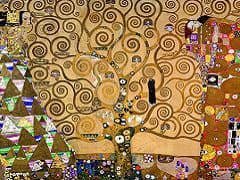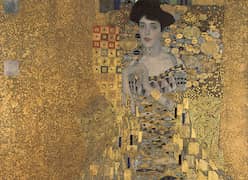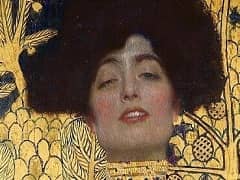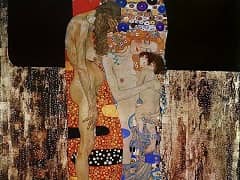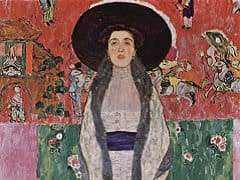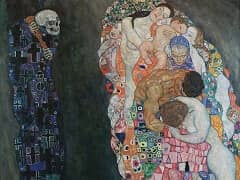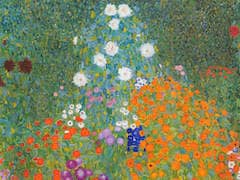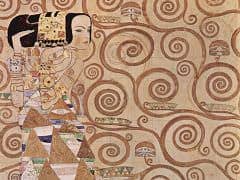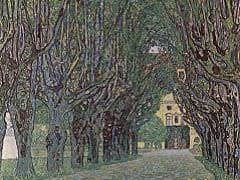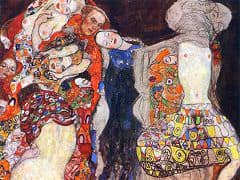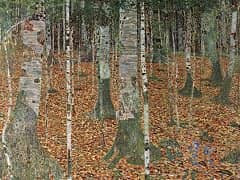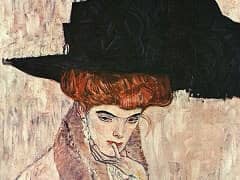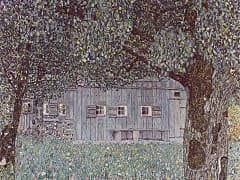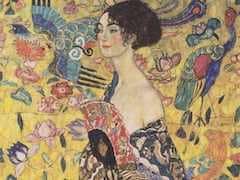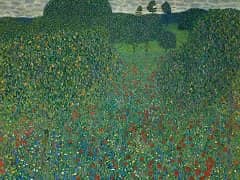10 Facts You Don't Know about "The Kiss" by Gustav Klimt

The Kiss is Klimt's most popular work and visitors flock annually to see it in Vienna's Austrian Gallery. At a remarkable 72in x 72in (180cm x 180cm), its powerful presence resounds from the wall as the life-size figures, wrapped in gold, embrace.
In 1903, Klimt traveled twice to Ravenna, where he saw the mosaics of San Vitale, whose Byzantine influence was apparent in the paintings of what would become known as his "Golden Period". The use of gold harked back to Klimt's own past, to the metal work of his father and younger brother Ernst, who had both died a decade earlier. Klimt's interest in the Byzantine period also symbolized a move towards greater stability, through static, inorganic forms; suggesting a search for refuge after the artist's exploration of the instinctual powers of archaic Greece. The Kiss representing the apex of his "Golden Period," this concludes similar thematic studies during his career, such as The Beethoven Frieze, and The Tree of Life. Each work aids final comprehension of the allegory, which represents the mystical union of spiritual and erotic love and the merging of the individual with the eternal cosmos.
Both figures are fully realized and symbolically blended as they face the golden abyss of perfection. The dominant male force is signified by the powerful coat of masculine black and gray blocks, softened by the feminine organic scrolling, reminiscent of "Tree of Life." In comparison, female energy is shown as spinning circles of bright floral motifs and upward-flowing wavy lines. From these vestments of artistic creation golden rain blesses the fertile earth, similar to the descending roses in "The Beethoven Frieze". The triangular fronds also recall water imagery from paintings such as Water Serpents. Here, Klimt's loosening of naturalism, in favor of a personal symbolic language suggesting the workings of unconscious mind, in particular its erotic urge, reached a climax. Through two figures, depicted not naked, but draped in densely patterned cloths, Klimt succeeded in evoking a moment of intense sensual pleasure, within a sharply stylized and flattened composition.
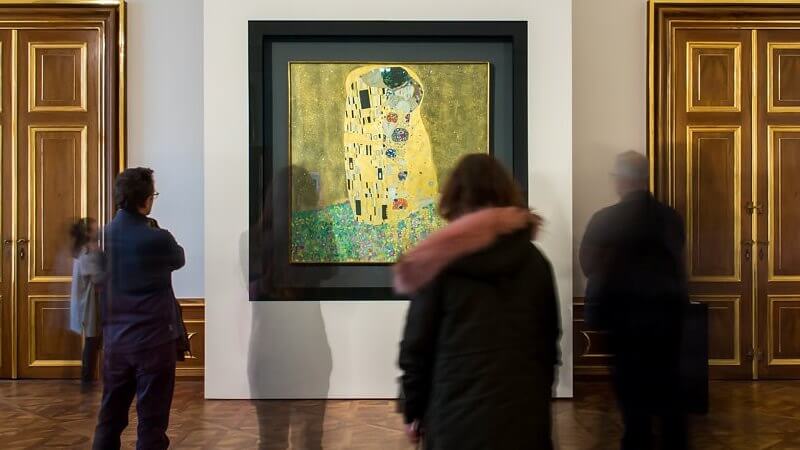
Records reveal that Klimt was a thickset and brooding man, usually photographed wearing his painter's smock, who never married and led an openly bohemian lifestyle. If Klimt preferred to allow his paintings to speak for him, then the message that The Kiss gave was extremely evocative - hinting, through their elaborate surfaces, at the workings of an enigmatic subconscious. It is no coincidence that Klimt's work is often linked to that of his Viennese compatriot, and near-contemporary, Sigmund Freud. When Klimt died in 1918, at the premature age of 55, several unfinished works of a strikingly sexual nature were found in his studio, as if revealing the erotic undercurrent latent beneath much of his earlier work.
"The Kiss" is Klimt's artistic response to the Byzantine mosaics at Ravenna, Italy, which so profoundly affected him. When re-assessing The Kiss for Klimt's 150th birthday, journalist Adrian Brijbassi wrote, "The Kiss by Gustav Klimt surpasses expectations," unlike that tiny and underwhelming Mona Lisa by Leonardo da Vinci. After throwing shade on the more famous painting, Brijbassi explained, "[The Kiss] does what a great piece of art is supposed to do: Hold your gaze, make you admire its aesthetic qualities while trying to discern what's beyond its superficial aspects."
10 Facts You Might not Know about "The Kiss"
1. The post-Victorian society of the early 1900s perceived "The Kiss" as pornographic, even though both figures are fully robed.
2. Despite the public outcry it generated, "The Kiss" sold before the artist had completely finished it. The Belvedere Museum of Vienna, Austria, was the purchaser.
3. The sale price of 25,000 crowns - roughly $240,000 in contemporary U.S. currency - was five times higher than that of than any painting previously sold in Vienna.
But that price turned out to be a bargain. Kimt's less renowned (though still quite famous) Adele Bloch-Bauer I sold
for $135 million in 2006. The New York Times noted at that time this was "the highest sum ever paid for a painting."
4. The painting is oversized, measuring approximately 6 x 6 feet.
5. The artist and the work are legal tender. In 2003, the Austrian Mint issued a 14-gram, 100-Euro gold coin showing Gustav Klimt's head and on the flip side, an etching of "The Kiss."
6. "The Kiss" is the final painting of Klimt's Gold Period, during which he incorporated gold leaf into his works. This practice reflects the strong influence of the gold-detailed religious
art of the Middle Ages as well as the sacred works created by artists of the Byzantine Empire. As a result, some considered such paintings as "The Kiss" to be sacrilegious.
7. The artist created "The Kiss," his most iconic painting, in the aftermath of dismal failure. During the first decade of the 20th century, Klimt completed a series known as the Vienna
Ceiling Paintings at the University of Vienna's great hall. Due in large part to the nude figures in this series, the established art community derided them as pornographic. Klimt
ultimately called upon the help of a wealthy patron to repay his commission of 30,000 crowns to Vienna's Ministry of Education and took his paintings elsewhere.
8. One factor that distinguishes "The Kiss" from the majority of the artist's works is its inclusion of a man and a woman together. Other paintings that feature both sexes include his
Beethoven Frieze from 1901, Fulfillment (The Embrace) from 1905 and Death and Life from 1910.
9. "The Kiss" is a ménage of different schools of art. The gold leaf hearkens back to such Byzantine artworks as the mosaics in the Church of San Vitale. The composition of the work
reflects the influence of Japanese prints that was also evident in some earlier Impressionist paintings. The contrasting patterns of the two lovers' cloaks reflects the Arts and Crafts
movement of the era and overall, Klimt imbued "The Kiss" with elements of his signature Art Nouveau style.
10. Toward the conclusion of World War II, the University of Vienna Ceiling Paintings were among a number of Klimt's artworks destroyed by retreating German troops. "The Kiss,"
however remains on exhibit at the Belvedere.


